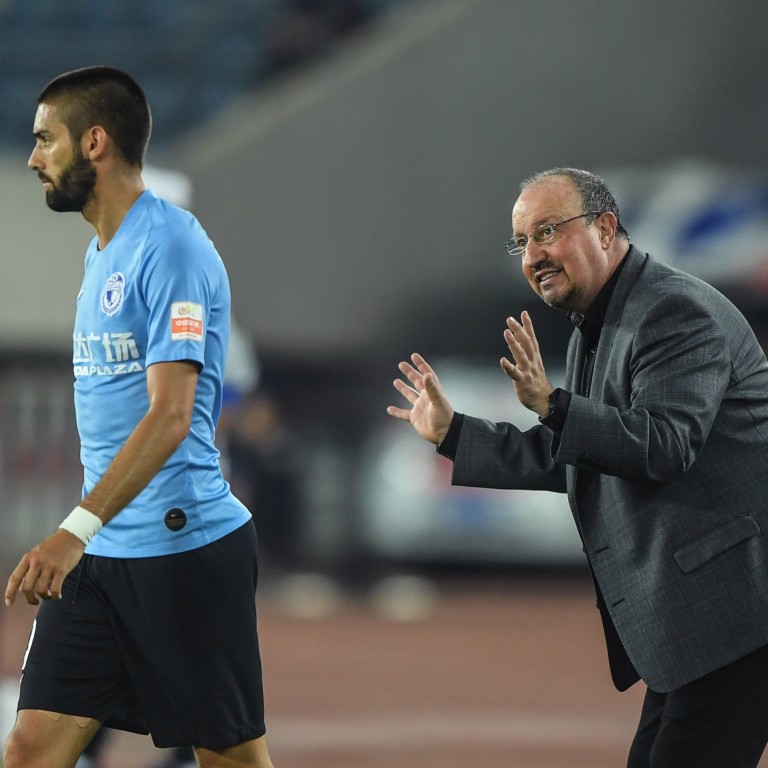
Chinese Super League’s millionaires live it up while League Two players protest unpaid wages ahead of uncertain futures at the end of the season
- China’s heads La Liga and English Premier League for largest gap between footballer’s wages and national average
- Several clubs in levels below CSL have struggled to pay their players this season and history suggests some will fold
A recently published report compared the wages of the world’s best footballers with the average annual salary of people in the country where they play.
The survey of 61 leagues conducted by Vouchercloud was done using football salaries from the Global Sports Salaries Report 2018 and national salaries taken from the World Bank.
China topped the list, with footballers earning US$1,051,603 and the average worker taking home US$6,597.93 per year in comparison. Footballers in China earn the average national wage in a little over two days.
The survey found Spain’s La Liga and the English Premier League to have the next largest disparities, with players earning 124 and 115 times more than their respective citizens.
Chinese football does not start and end with the Chinese Super League and the good news for footballers is largely confined to those in the top flight or big-name imports like Yaya Toure at League One promotional hopes Qingdao Huanghai.
In the tiers below, an increasing number of players are protesting going unpaid by their club, despite Chinese Football Association measures to try to guarantee their payment.
Jamie McIlroy, a long-time observer of Chinese football based in the central city of Wuhan, has been tracking the situation.
“Five League Two clubs have had players specifically protesting at unpaid wages. At least two other clubs have been widely reported [as] not paying their salaries,” he said. “There’s probably more.”
As early as January, before the 2019 season kicked off, players from Hainan publicly protested being owed unpaid salaries. Since then several more have gone public with Dalian players said to be owed six months of salary and Ningxia players holding up a banner protesting their own unpaid wages after a game in August.
That situation was even more public after players commented on club statements on micro-blogging site Sina Weibo.
Teams in Jilin, Hunan, Yinchuan, Shanxi and Yunnan have either protested or been mentioned as owing money to their players and staff.
“The problem is that they are expanding league two every season,” said McIlroy. “It’s expanding by four teams every year. There was 20 teams four years ago. It’s now 32 and next year it will be 36. These teams are all promoted from the amateur leagues.
“A lot of them just don’t have the financial backing, they don’t have any way to make their own money. They are entirely dependent on the generosity of the owners and sponsors. There isn’t enough support base for them to make money. Some will get help from the local FAs and some of them won’t.”
Oddly, it might not actually be getting worse. “At least this year all the clubs actually made it through the season,” McIlroy said. Last year, two teams didn’t make it through the end of the year without dropping out. It looks like more teams will go out of business.”
That happened last winter in the break between seasons when Dalian Transcendence, Shanghai Sunfun, Shenzhen Ledman, Hangzhou Wuyue Qiantang and Yingkou Chaoyue all failed to submit paperwork for their finances to the CFA before the 2019 season and dropped out. Shenyang Dongjin and Hefei Guiguan were booted out midway through the season in June.
More will dissolve once this season is concluded, potentially even Shanghai Shenxin, if reports are to be believed. The club has been relegated from League One with three games left of a season where they struggled to play all their matches.
Two years ago they were semi-finalists in the Chinese FA Cup, losing to eventual winners Shanghai Shenhua.
Financial troubles are nothing new in Chinese football, nor, as we have seen with Bury, Bolton Wanderers and a host of other English clubs, are they limited to China.
China’s most successful club, Guangzhou Evergrande, only kicked on after the real estate company invested and took over League One side Guangzhou Pharmaceutical. Investment is no guarantee of success, of course, as English club Sheffield United’s failed experiment owning the Chengdu Blades showed.
It’s not putting everyone off trying. Earlier this year, Sichuan Jiuniu became the seventh club in Manchester City owners City Football Group’s stable.
“China is an extremely important football market, which we have been focused on for some time,” said City Football Group CEO Ferran Soriano at the time. “We believe strongly in the future of football in China.”
There are plenty of players who wished the owners of their clubs felt the same. Instead, as we have seen in recent weeks, they are more likely to be playing alongside them.
A recent League Two game between Jilin and Xi’an saw investors lining up for both sides.

